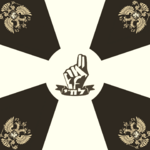Lokhamy Kheyrut

Lokhamy Kheyrut (Hebrew for "Freedom Fighters" or "Freedom Warriors") were an assortment of irregular right-wing irrdentist militias and paramilitaries affiliated with the Kingdom of Pavulturilor that were established in the wake of its defeat in the Second Călăneasan War with the goal of reclaiming Dacia. These formations varied in both role and streangth with ranging from infantry to artillery and in size from a company to entire brigades.
while inititally operating independantly from the government,by 1862 as the Dacian Conflict grew in intensity, the Kingdom of Pavulturilor sent advisors and equipment to Lokhamy Kheyrut units in secret.
Formation
Following the end of the Second Călăneasan War with the September Agreement, which forced Pavulturilor to recogize Northern Dacia as an independant country, losing access to much of the natural resources of the region, projected to have a devestating effect on the Pavulturilori economy, coupled with the loss and inability to re-pay War Bonds, led to an economic reccession. Many of the de-mobalized soldiers who faught in the war were disatisfied with the central government and its handling of the situation, which led them to form as roaming bands of rogue soldiers of various spacialities, often using corruption and other connections to the military proper to arm themselves, such as in the case of the Totkhaney Ha'Melekh militia, who were an artillery unit.
Activities
A month after the end of the Second Călăneasan War the first skirmishes along the Pavulturilori-Northern Dacian border occured between the Socialist Dacian War Council and various Lokhamy Kheyrut formations, particularly along the Duben River and Kanar Lake.
In late 1862, The Pavulturilori Government understood that they could bypass the September Agreement, by using Lokhamy Kheyrut formations to fight the Dacians on their behalf, and thus began to change its stance on these formations, from illegal and dangerous paramilitaries which need to be prosecuted, to vigilanties that need no interferance, and went so far as to secretly arm a select few of these formations, such as Ha'Parashim Ha'Shkhorim and Ha'Moaatza Le'Shikhrur Dacia.
With new arms and support, most major Lokhamy Kheyrut factions joined in a loose coalition branded the Committee For the Re-Patriotation of Dacia on 15 August 1862, and to declare proper war upon Northern Dacia. beggining the Duben River Campaign, and follow up on it with the 1863 Spring Offensive. After which, the front would stagnate due to disagreements within the committee's high command, leading to its dissolution on the 16 February 1864. While there were numerous raids of small Lokhamy Kheyrut formations on Dacian Positions, the war would not progress much until the 1865 Winter Offensive, which started as a result of a massive artillery bombardment of the Totkhaney Ha'Melekh formation, which was followed up with multipule infantry and cavalry charges across the front as the bombardment was allegedly heard across the entire front.
It would not take long until the first Lokhamy Kheyrut formations reached the Dacian capital of Comăști, while some chose to set camp outside and take pot-shots at the defenders, some chose to enter the city and fight to the bitter end, when the larger formations sttarted to reach the city's outskirts, the Dacian Government elected to surrender, in the following week, the various formations was unanimus in their treatment of communists and socialists they found, that of summery excecution, which resulted in The Week of Blood.
Demobalization
Following the end of the Dacian Conflict with the Re-Patriotation of Norther Dacia, most formations have naturally dissolved as they percived to have "Righted the great wrong".
Symbology
Many Lokhamy Kheyrut formations had their own identification symbols, and took great pride in them, a pesudo-culture revolved around Lokhamy Kheyrut standards and banners among themselves.
Standard of the Committee For the Re-Patriotation of Dacia.
- Ligyon Dacia.png
Standard of Ligyon Dacia
- Moaatza Dacia.png
Standard of Ha'Moaatza Le'Shikhrur Dacia
Banner of Ha'Parashim Ha'Shkhorim
- Totkhanim.png
Standard of Totkhaney Ha'Melekh
Standard of Kidoney Ha'Barzel
- Lokhamin2.png
Standard of Khayaley Ha'Malkhut
- Lokhamin3.png
Banner of Plugat Ha'Makhatz



